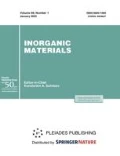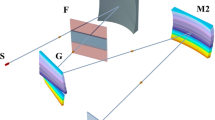Abstract
Modern small-sized spectrometers are mainly designed by the Czerny–Turner scheme with a flat diffraction grating or, if the goal is to obtain the maximum aperture at the expense of resolution, by the scheme with a concave diffraction grating. In such spectrometers, the spectrum is registered by photodiode array. In this work, we provide an overview of characteristics of the compact spectrometers developed by our group. These spectrometers use caseless linear photodiode arrays for spectrum registration that eliminates the reflection of radiation from the cover glass of the photodiode array and reduces stray light. The tightness of the housing of spectrometers prolongs their service life. The parameters of the spectrometer modifications designed according to the Czerny–Turner scheme are given. The main advantage of the spectrometer of this type is the low stray light inside the device and the same spectral resolution throughout the spectral range. Aberrations limit the working aperture in the Czerny–Turner scheme to 1/6. The scheme with a flat field allows operation with a larger working aperture. Three modifications of the spectrometer have been developed according to this scheme; a description of their main parameters is given. The results of experimental comparison of the light gathering power and spectral resolution of spectrometers with different optical schemes, as well as the examples of their application, are presented. Devices designed according to the Czerny–Turner scheme are used in atomic emission and atomic absorption spectral analysis and in spectrophotometry for registration of absorption spectra of condensed media. The spectrometers with flat field are used for recording luminescence and Raman spectra of minerals. The developed compact spectrometers can work in a spectral range of 190–1100 nm with the width of the recorded spectral range from 70 to 1000 nm; the best spectral resolution is 0.1 nm, the stray light level is less than 0.05%, and the maximum measured optical density exceeds 3. Owing to a large working aperture of 1 : 2.1, the flat field spectrometers have an increased light gathering power.




Similar content being viewed by others
REFERENCES
Labusov, V.A., Devices and systems for atomic emission spectroscopy produced by VMK-Optoelektronika, Zavod. Lab., Diagn. Mater., 2015, vol. 81, nos. 1–2, pp. 12–21.
Tang, M., Fan, X., Wang, X., et al., General study of asymmetrical crossed Czerny-Turner spectrometer, Appl. Opt., 2015, vol. 54, no. 33, pp. 9966–9975.
Labusov, V.A., Put’makov, A.N., Saushkin, M.S., et al., Multichannel Kolibri-2 spectrometer and its use for simultaneous determination of alkaline and alkaline-earth metals by the method of flame photometry, Zavod. Lab., Diagn. Mater., 2007, vol. 73, special issue, pp. 35–39.
Belokopytov, A.A., Lukin, A.V., Maksakova, L.A., et al., Fast concave holographic flat-field gratings for small-sized spectrometers, Trudy 12-i Mezhdunarodnoi konferentsii GoloEkspo-2015 “Golografiya. Nauka i praktika,” 12–15 oktyabrya 2015 g. (Proc. 12th Int. Conf. GoloExpo-2015 “Holography: Science and Practice,” October 12–15, 2015), Kazan, 2015.
Palmer, C., Diffraction Grating Handbook, New York: Newport Corporation, 2014, 7th ed.
Zhou, Q., Li, X., Ni, K., et al., Holographic fabrication of large-constant concave gratings for wide-range flat-field spectrometers with the addition of a concave lens, Opt. Express, 2016, vol. 24, no. 2, pp. 732–738.
Peisakhson, I.V., Optika spektral’nykh priborov (Optics for Spectral Devices), Leningrad: Mashinostroenie, 1975, 2nd ed.
Put’makov, A.N., Zarubin, I.A., Burumov, I.D., and Selyunin, D.O., Spectrometer Pavlin for flame atomic emission spectrometry, Zavod. Lab., Diagn. Mater., 2015, vol. 81, nos. 1–2, pp. 105–108.
Zarubin, I.A., Capabilities of a compact Kolibri-2 spectrometer in atomic emission spectral analysis, Zavod. Lab., Diagn. Mater., 2017, vol. 83, nos. 1–2, pp. 114–117.
Estrada, C.F., Changing the science of mineralogy: the use of Raman spectroscopy in mineral identification and the RRUFF project, Outcrop, 2007, vol. 55, pp. 1–8.
Funding
The authors declare that they have no conflicts of interest.
Author information
Authors and Affiliations
Corresponding author
Additional information
Translated by V. Alekseev
Rights and permissions
About this article
Cite this article
Zarubin, I.A., Labusov, V.A. & Babin, S.A. Characteristics of Compact Spectrometers with Diffraction Gratings of Different Types. Inorg Mater 56, 1436–1440 (2020). https://doi.org/10.1134/S0020168520140162
Received:
Revised:
Accepted:
Published:
Issue Date:
DOI: https://doi.org/10.1134/S0020168520140162




